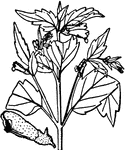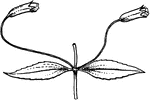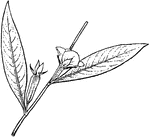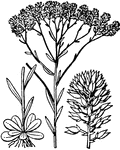
Leaves mostly basal, heart shaped; flowers purple.

Sheaths around stem above each point of leaf-attachment; flowers white to red, not fragrant.
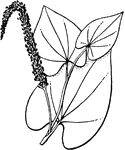
Stems with no sheaths; flowers white, fragrant.
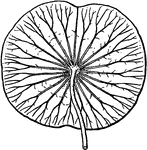
Leaves large, 2 dm or more in diameter, impossible to wet; flowers solitary, showy, yellow.

Leaves with several very prominent ribs running from base to apex.
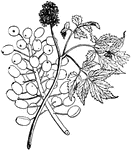
"Red Baneberry, showing flowering plant and fruiting raceme."-Whitney, 1902
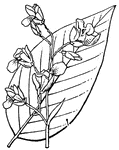
Plants white-powdery above; plants extremely large, usually over 1 m.

Plants smaller; not wite-powdery above; leaves shed water easily; flowers along fleshy spike enclosed…

Flowers many; leaves large, over 10cm long.

Flowers solitary; leaves small, less than 5 cm long.

Leaf, when examined against light with lens, showing semitransparent dots; flowers yellow or pink.

Flowers not showy, in axils of leaves, mostly purple.

"Adlumia cirrhosa; single leaf and panicle"-Whitney, 1902
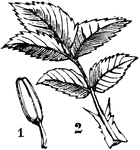
"Adnate Anther, Adnate Stipule."-Whitney, 1902

Leaves covered with tiny black dots visible with lens; flowers small, white.
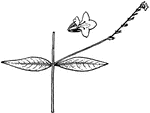
Flowers irregular, purplish.

Stems woody at least at base, arching; flowers purple-pink, in auxiliary clusters.
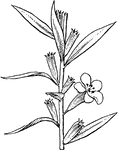
Flowers purple; plant usually corky at base.
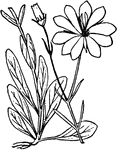
Flowers white, or, if pink, with a yellow or green eye in the center.

Flowers in terminal clusters.

Flowers small, white, gathered in dense, sessile clusters in the axils of the leaves.

Leaves small, mostly under 3cm long; usually with black dots visible with a lens covering them.

Plants decumbent at base and usually rooting at the lower nodes.

Leaves long petioled; flowers inconspicuous.
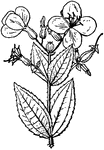
Leaves sessile or very short petioled; flowers showy.

Leaves long petioled; flowers minute, in sessile clusters on branch.
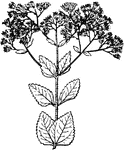
Flowers white or purplish.

Leaves large, mostly over 6 cm wide; flowers yellow, very large.

Leaves smaller; flowers individually small, in terminal spike-like clusters.
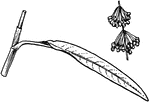
Plant with broad leaves, many basal; flowers stalked and drooping.
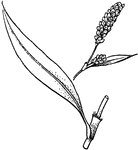
Plant with narrower leaves, none basal; flowers sessile, in terminal spikes.

Leaves not over twice as long as broad.
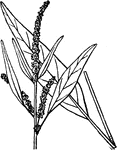
Large herb with a very stout stem, often from 1 to 3dm in diameter at base, over 1.5m tall.
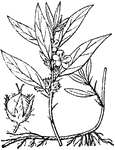
Sepals united at base into a tube enclosing the ovary and later the fruit; leaves with spines in axils.

Sepals longer than the calyx tube, reflexed.
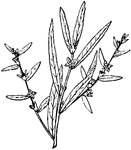
Capsule or calyx tube short and stout, not reflexed.
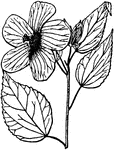
Large leaves, over 5 cm broad; flowers large, over 5cm across.
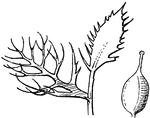
Flowers conspicuous, white, 4-petaled.
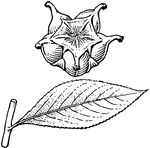
Flowers greenish, 5-petaled.

Flowers sessile, in the axils of the leaves; fruit a single 3-angled nutlet.

Flowers stalked; fruit a group of several, scarcely angled, small nutlets.

"Century-plant. A large North American genus of plants, of the natural order Amaryllidaceæ, chiefly…

"Seeds cut vertically, showing their Embryos and Albumen."-Whitney, 1902
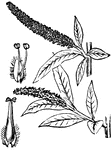
"Ament-A kind of inflorescence consisting of unisexual apetalous flowers growing in the axils of scales…

"The numerous species of Coccinellae feed upon aphides, or Plant lice, both…

Tobacco plant

"Aphis; a genus of small plant-sucking insects, of the family Aphididæ and order Homoptera."-Whitney,…

"Aphis; a genus of small plant-sucking insects, of the family Aphididæ and order Homoptera."-Whitney,…
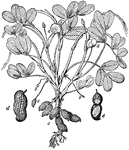
"Common Peanut (Arachis hypogæa). a, flowers; b, ovaries on lengthened stipes; c, forming fruit;…

"Cacao, or cocoa, is the chocolate tree, and also the powder and beverage made with it obtained from…

"This may be considered as one of the greatest wonders of nature, it being a real animal, having blood,…

Chicory is a flowering plant with blue flowers, originally from the Old World but now seen growing wild…































